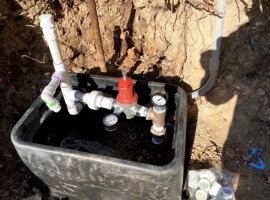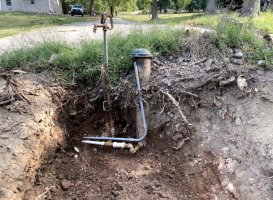Hardyh
Member
Here is our setup, I got some help here last year regarding a recurring dry pump situation (thank you very much!). Everything worked great over the winter but I think that our combined houses water use (with little gardens, etc) in the summer is still affecting the system.
Here is an image of the setup:

We drop pressure to 10-15PSI occasionally, sometimes when I am using water at the main house and I assume sometimes when the upper house is using water or maybe if there is an overlap in usage. I am hoping to install a CSV to sort this out but with the placement of our well between the two houses and a yard hydrant right at the well is a CSV even an option? The well is not housed (it's out in the open) so is there a way I can install the CSV without weather or freezing affecting it? Can these valves be buried or do I need to maintain easy access for maintenance or testing? Any other suggestions? We are hoping to switch the upper house to a passively filled sistern style rather than drawing directly from the well but that wouldn't happen until after the summer.
Here is an image of the setup:
We drop pressure to 10-15PSI occasionally, sometimes when I am using water at the main house and I assume sometimes when the upper house is using water or maybe if there is an overlap in usage. I am hoping to install a CSV to sort this out but with the placement of our well between the two houses and a yard hydrant right at the well is a CSV even an option? The well is not housed (it's out in the open) so is there a way I can install the CSV without weather or freezing affecting it? Can these valves be buried or do I need to maintain easy access for maintenance or testing? Any other suggestions? We are hoping to switch the upper house to a passively filled sistern style rather than drawing directly from the well but that wouldn't happen until after the summer.


